
Posted on 02/18/2012 4:56:23 AM PST by Homer_J_Simpson





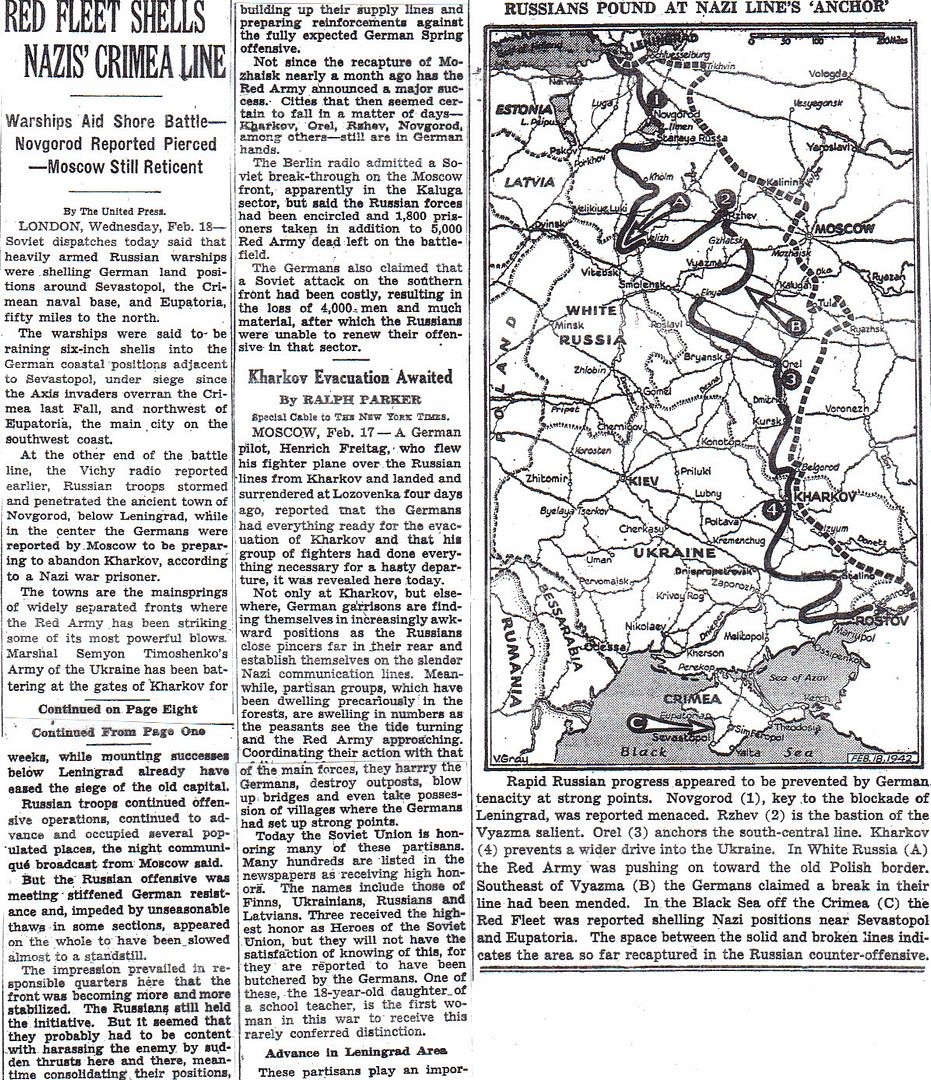


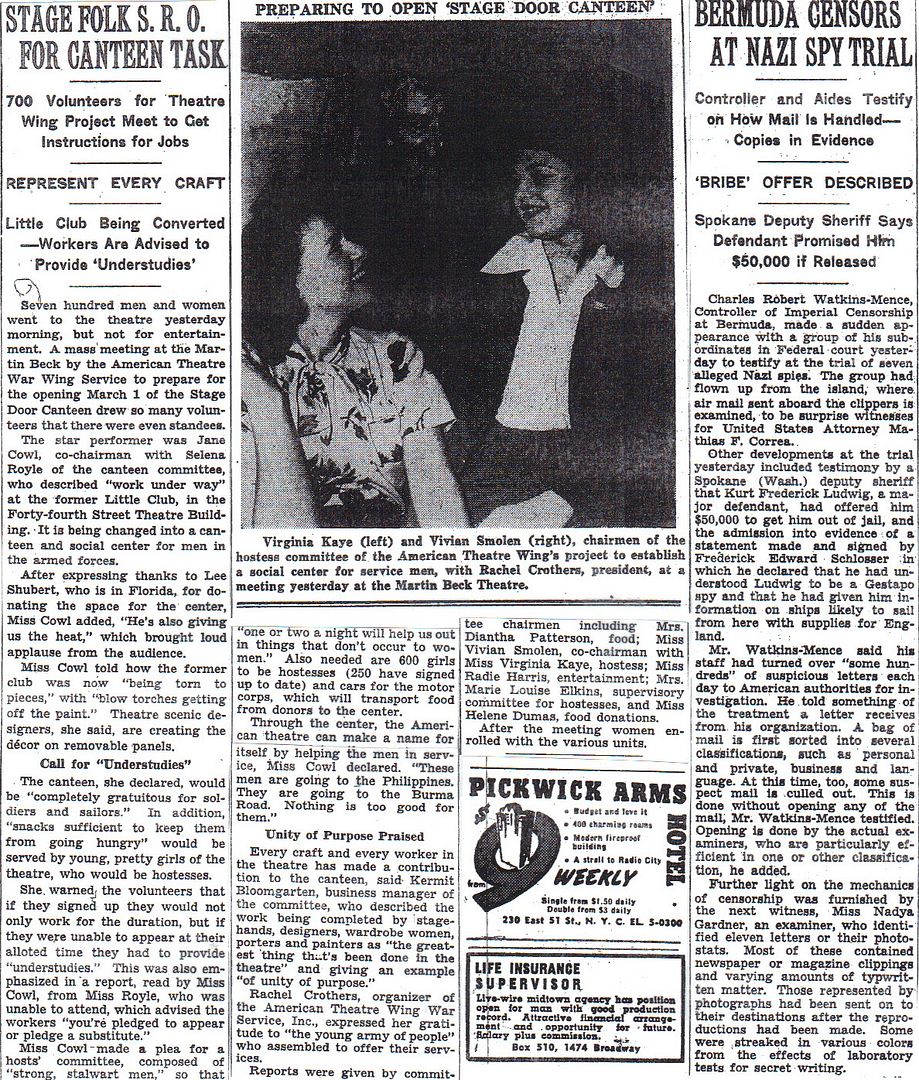

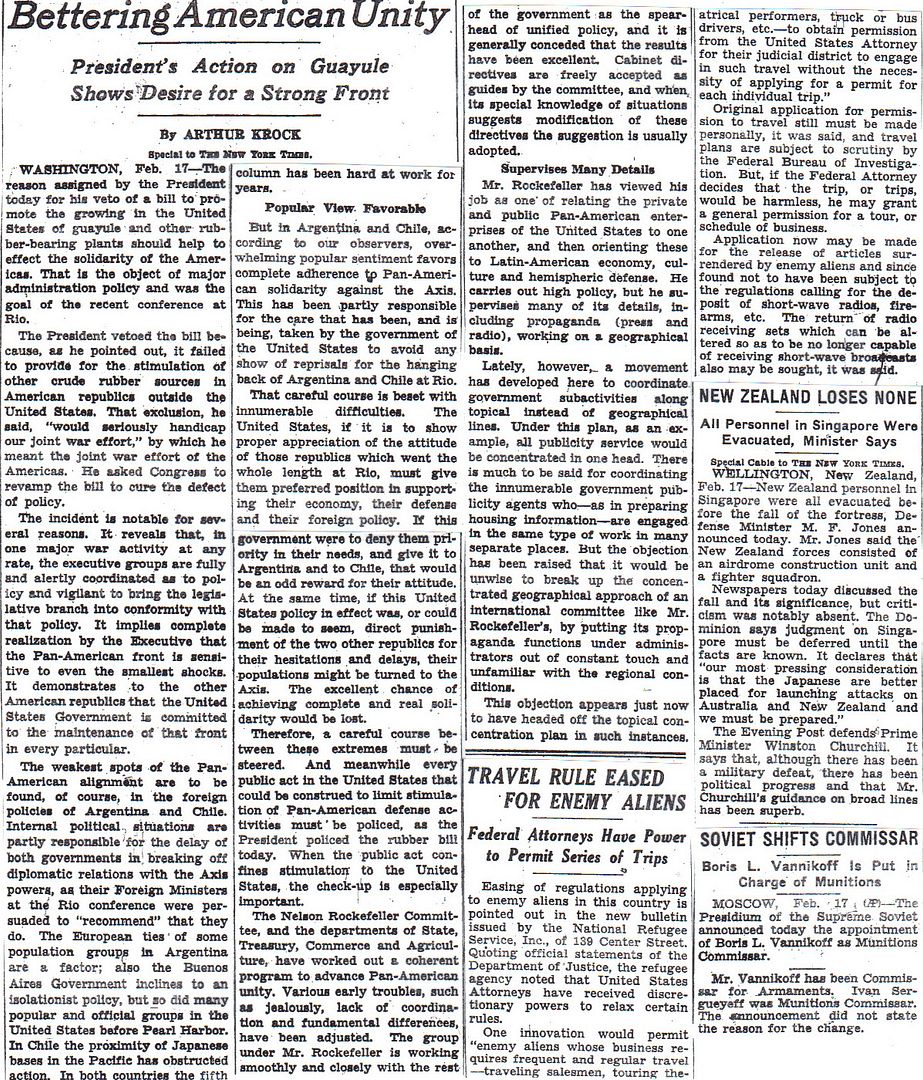

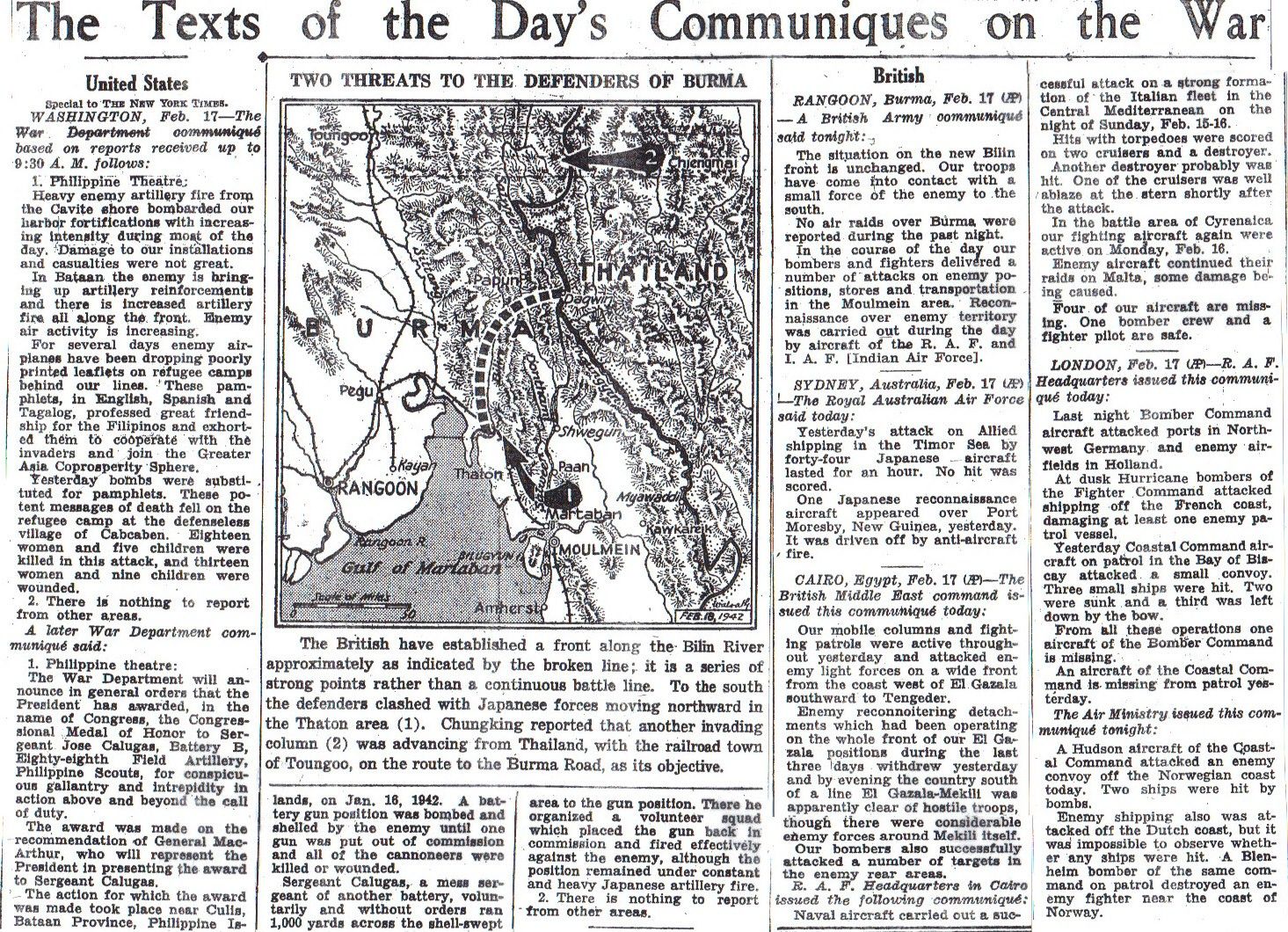
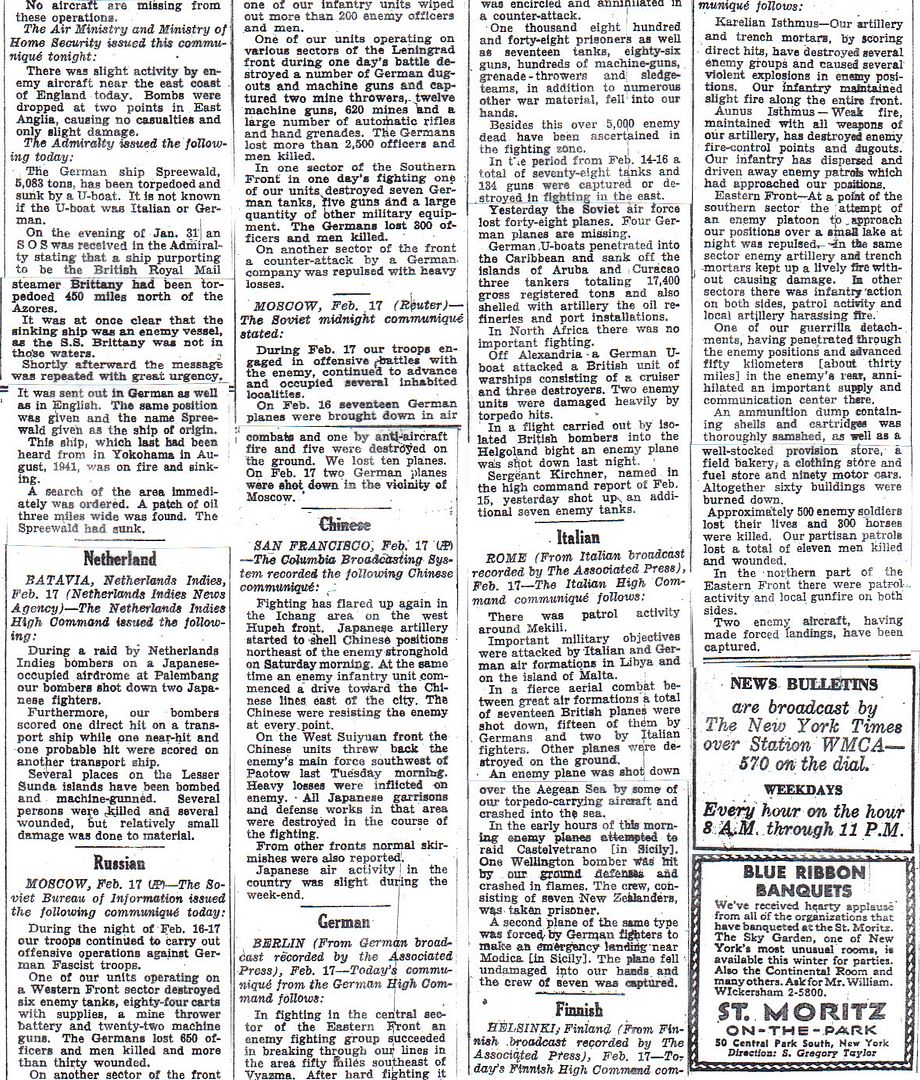
http://www.onwar.com/chrono/1942/feb42/f18feb42.htm
British and Australian planes leave Sumatra
Wednesday, February 18, 1942 www.onwar.com
In the Dutch East Indies... British RAF and Australian RAAF units are withdrawn from Sumatra to Java.
In the Gulf of Mexico... The Free French submarine Surcouf (then the largest submarine in the world) is sunk in a collision with a US merchant ship.
http://homepage.ntlworld.com/andrew.etherington/month/thismonth/18.htm
February 18th, 1942
UNITED KINGDOM: Westminster: Miners are exempted from soap rationing.
Destroyer HMS Wilton commissioned. (Dave Shirlaw)
NORTH SEA: Minesweeping trawler HMS Botanic sunk by German aircraft. (Dave Shirlaw)
FRANCE: During the night of the 18-19th, six RAF Bomber Command aircraft drop leaflets over Paris and Lille. (Jack McKillop)
THE NETHERLANDS: During the night of the 18-19th, RAF Bomber Command dispatches 25 Hampdens on a mining mission over the West Frisian Islands. (Jack McKillop)
GERMANY: U-259 commissioned. (Dave Shirlaw)
BURMA: Japanese forces cross the Bilin river, and Britain orders Rangoon to be evacuated.
NETHERLANDS EAST INDIES: A British volunteer party from Batavia, Java, sails to Oosthaven, Sumatra, retrieved valuable aircraft spares and technical stores and destroyed what was left, including the harbor facilities without interference from the Japanese. (Jack McKillop)
The air echelon of the USAAF 5th Air Force’ 91st Bombardment Squadron (Light), begins operating from Malang, Java, with A-24 Dauntlesses; the ground echelon is on Bataan, Luzon, Philippine Islands. (Jack McKillop)
Against the wishes of Lieutenant General John Lavarack, General Officer Commanding I Australian Corps, General Archibald Wavell, Commander in Chief American-British-Dutch-Australian Command, orders the Australian Imperial Force troops on the fast passenger liner SS Orcades to disembark at Batavia, Java. The next day, Wavell informs Australian Prime Minister John Curtin that these troops are need for airfield defence and are being disembarked. (Jack McKillop)
USAAF 5th Air Force P-40 pilots attack nine Japanese bombers over Soerabaja, Java, shooting down six of the bombers for the loss of one P-40. Three Japanese fighters are also shot down in separate engagements over Soerabaja. (Jack McKillop)
On Timor island the Japanese land at Dilli. Twenty men of the 2/2nd A.I.F. Independent Company blow up the airstrip and fight their way back into the hills to join the other units of the garrison to start a bitter guerilla war against the Japanese. (Michael Alexander)
Submarine HNLMS K VII sunk by Japanese aircraft at Surabaya. All hands lost. (Dave Shirlaw)
The Battle of the Badung Strait
During the day a small Japanese Navy convoy under Rear-Admiral Kubo Kyuji flying his flag on the light cruiser Nagara, with seven destroyers (Hatsushimo, Nenohi, Wakaba, Asashio, Oshio, Arashio, and Michishio), escorted the transports Sasego Maru and Sagami Maru to Bali (East of Java), where they landed one reinforced battalion of IJA troops to capture seize the airfield there. Throughout the day Kubo’s force was subjected to a large number of air attacks by US and Dutch aircraft. However, despite glowing reports of damage, only one hit was scored on Sagami Maru, temporarily disabling her engines. As dusk approached, Kubo began withdrawing his force in three elements. His flagship, with Hatsushimo, Nenohi, and Wakaba sortied immediately. Sasego Maru, escorted by Arashio and Michishio followed some time later at a much slower speed, while Sagami Maru, under the protective eyes of Oshio and Asashio would leave as soon as temporary repairs were completed.
When the Japanese convoy force had been sighted on 17 February by ABDA search planes, the sighting could not have come at a worse time. The Allied warships of ABDA’s Combined Striking Force had just returned from a sortie and had been forced to separate to several Dutch ports for fuel and maintenance. None the less, Schout-bij-Nacht [Rear-Admiral] Karel Willem Frederick Marie Doorman, KM immediately issued orders for all of his available ships to sortie. His hastily worked out plan was to see a sustained attack in three waves. First, in would be Doorman’s main force, consisting of the Dutch light cruisers De Ruyter and Java and three destroyers, the Dutch Piet Hein along with USS Pope and USS John D. Ford. The second wave would be composed of four American Destroyers, USS Stewart, USS Parrott, USS John D. Edwards, and USS Pillsbury supported by the Dutch light cruiser Tromp. The third wave was composed of seven Dutch motor torpedo boats, TM-4, TM-5, TM-7, TM-9, TM-10, TM-11, and TM-12. Doorman hoped for great things as, for the first time in the campaign, the Allied forces would be numerically and qualitatively superior to the Japanese.
In the event, the Battle of Badung Strait could not have gone much worse. By 2220 ,when Doorman arrived, the only Japanese ships in the immediate area were the damaged Sagami Maru, and her two escorts. In a very confusing action, the Dutch cruisers steamed merrily through the strait seeing little, only Java engaging, albeit briefly. However, his trailing destroyers found themselves in a regular brawl form which only two emerged, Piet Hein being disabled by gunfire and then sunk by a torpedo from Asashio. meanwhile, the other Japanese forces turned about to offer support to their colleagues.
Following in roughly two hours later the US destroyers, supported by Tromp, found themselves in an old fashioned gunfight, first with Asashio and Oshio, and then with Michishio and Arashio. Again, the results did not favour the Allies. Tromp, battered by 18 shells by the time the action was over, would have to leave the campaign for Australian dockyard at Sydney. However, the US destroyers earned some measure of revenge, knocking about Oshio and plastering Michishio, which which went dead in the water with her entire powerplant “hors de combat”. She had to suffer the indignity of being towed home and was not fully repaired until October.
The finishing touches on this less than spectacular affair were applied by the Dutch MTBs, which sailed straight through the center of the Strait without seeing a thing! Thus ended the Combined Striking Force’s best opportunity to inflict some real damage on the Japanese Navy. (Mark E. Horan)
More...
SINGAPORE: British and Australian POWs are forced to sweep the streets, while Japanese newsreel cameras roll, showing Western weakness. Singapore is re-named “Shonan,” meaning “Bright South,” and Japanese troops start removing British statues, signs, and memorials. (Jack McKillop)
AUSTRALIA: U.S. Major General George H. Brett, acting in his capacity as deputy commander of the American-British-Dutch-Australian Command, cables the U.S. War Department with his assessment that the only way to save Java is to mount an immediate ground and air offensive in Burma and China. Therefore, he orders Major General Lewis H. Brereton, Commanding General USAAF 5th Air Force, to travel to India to oversee the building of an air force there. Brett also advises that an American buildup in Australia should be implemented at once. (Jack McKillop)
Destroyer HMAS Bataan laid down.
Minesweeper HMAS Wallaroo launched. (Dave Shirlaw)
NEWFOUNDLAND: The USN destroyer USS Truxtun (DD-229) and stores issuing ship USS Pollux (AKS-2) run aground during storm near Placentia Bay; the former just east of Ferryland Point and the latter off Lawn Point. Minesweeper USS Brant (AM-24) arrives on scene and contributes rescue parties as well as brings medical officer and corpsmen from destroyer tender and Support Force flagship, the destroyer tender USS Prairie (AD-15). The tragedy produces deep admiration for the lifesaving efforts of the local population. “Hardly a dozen men from both ships would have been saved,” one observer writes later, “had it not been for the superb work of the local residents.” Many men jeopardize their own lives frequently to save the American sailors; several hang by lines over the cliffs to keep survivors from dragging over sharp rocks as they are pulled up from the beach below; others go out in a dory, risking swamping several times in the rough waves; after working all day rescuing USS Truxtun’s people, some of the local inhabitants then toil all night rescuing USS Pollux’s men with a stamina that defies description. Though poor, the men, women, and children of the town of St. Lawrence turn out to outfit the “survivors with blankets, warm clothes, boots, fed them, cleaned them up as best they could and turned them in their own beds.” Subsequently, they turn a deaf ear to offers to pay for food and clothing used in succouring the shipwrecked Americans. (Jack McKillop)
CANADA: Training ship HMCS Skidegate paid off. (Dave Shirlaw)
U.S.A.: Washington: Internment camps are being prepared in Arkansas and Texas to house thousands of Japanese-Americans, many of them second-or third-generation citizens who are to be moved from the west coast as an anti-invasion measure.
The decision was taken at a meeting at the attorney-general’s home between officials of the justice and war departments. The president took no part.
The army is keen to relocate all Japanese. When the assistant secretary of war, John J. McCloy, questioned the legality of the move, a senior officer on the coast, General John de Witt, told him: “Out here, Mr. Secretary, a Jap’s a Jap”.
GULF OF MEXICO: The Free French submarine Surcouf, the world’s largest, sinks in a collision with a US merchant ship near the entrance to the Panama Canal. There are no survivors of the 130-man crew. (Jack McKillop)
A Brazilian freighter SS OLINDA is stopped by German submarine U-432 with a shot across the bow. After questioning the crew, the ship is shelled, torpedoed and sunk by about 78 miles (126 kilometres) northeast of Norfolk, Virginia at 2100. (Jack McKillop)
CARIBBEAN SEA: A U.S. ship, the 2,340-ton Matson freighter Mokihana,is torpedoed by German submarine U-161 while lying at anchor at Port of Spain, Trinidad; there are no casualties among the 36-man merchant crew or 9-man Armed Guard. The ship stays afloat and is repaired. (Jack McKillop and Keith Allen)(279)
ATLANTIC OCEAN: SS Somme sunk by U-108 at 35.30N, 61.25W. (Dave Shirlaw)
Thanx for the ping.
At least they didn't drive bamboo-shoots under its fingernails.
Disclaimer: Opinions posted on Free Republic are those of the individual posters and do not necessarily represent the opinion of Free Republic or its management. All materials posted herein are protected by copyright law and the exemption for fair use of copyrighted works.